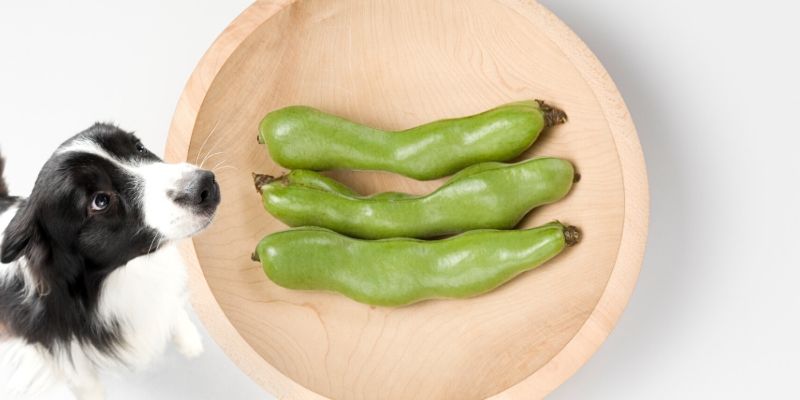The quick answer is: “Yes.” These beans have significant health benefits for everyone, including your pet. They’re an awesome source of polyunsaturated (good ones) fats, particularly of omega-3 alpha-linolenic acid.
This nutrient proved to help reduce the risk of diabetes, obesity and even support the health of the skin and fur. Especially if your are feeding them plain with no sauces or salt added.
But let’s get into the details.
Do you have a specific question about edamame and dogs? Then use the table of contents below to jump to the most relevant section. And you can always go back by clicking on the black arrow in the right bottom corner of the page. Also, please note that some of the links in this article may be affiliate links. For more details, check the Disclosure section at the bottom of the page.
Here's what we'll cover:
Edamame beans are one of the most typical food in countries like Korea, China, and Japan.
Edamame is young green soybeans steamed or boiled and served in their pods. It’s an excellent source of protein and has various health advantages. The recent research found that consuming 47 grams of soy-based protein per day can reduce LDL (the “bad”) cholesterol levels by 12.9%.

Edamame also is recognized to be a prominent source of nutrients: if you eat a serving of this beans ( a cup of 155 grams), you will end up more than 100% of the recommended daily intake of folate and 52% of vitamin K.
That’s to name a few.
So you might consider integrating Edamame beans into your diet (great choice!) and also wondering if your dog can join?
You’ve come to the right place.
You might also like:
- Dog Food Samples: How to Get More Freebies for Your Pup?
- Top 9 Dream Gifts for Dog Lovers: From Dog Art to Pup’s Twin
- Dog Subscription Boxes: 5 Reasons to Get In and Is There Really an Option Under $10?

Is edamame good for dogs?

Definitely.
On top of healthy fats for pups skin and fur care, edamame is also a source of protein and fiber. Proteins are great to provide enough energy to fuel your pup’s active lifestyle. Fiber is amazing for weight management.
As it helps dogs feel saturation faster and longer and therefore reducing the risk of overeating.
Edamame is a sound bite for dogs on a diet. Mass-produced dog treats are high calories and fats most of the time and is a strict no for pups who have to shed a few pounds.
Consider treating your pup with some edamame beans as a healthy alternative.

We have a great guide on how to put a dog on a diet here in case if it’s the topic of you and your pet’s interests.

Is edamame bad for dogs?

No. Edamame is not toxic to risky at any other way to your dog nor does it have negative effects on their health. The only predicament is the potential dog’s response to a new food. So, at first, only serve your dog 1-2 edamame beans and watch if they demonstrate any unfavorable reactions, like vomiting or stomach’s upset.
Anytime you make some adjustments in your dog’s diet or offer a new food to their menu that their digestion has not encountered previously, there’s always the possibility that your dog’s body might not embrace that food readily. So, you have to integrate any adjustments gradually at first.


Is edamame safe for dogs?
Generally, edamame is safe for dogs to eat. Just don’t serve your pet roasted edamame beans that sometimes are sold in supermarkets like ones. Those are often cooked with seasonings (possibly dangerous), oil (very fatty), or excessive amounts of salt.
And too much of it can lead to diarrhea, dehydration, and potentially salt poisoning. Edamame blended in with frozen vegetables has some history with onions or garlic, and even one molecule of any of those two put your pup’s well-being at risk. So skip those too.
Green steamed edamame beans, no seasoning, are the best to share with your dog. Be careful with pods; those can cause choking. So, when giving edamame to your pet, it has to be peeled.

How much edamame for dogs is safe?

When you first introduce your dog to edamame it has to be a smaller portion, like 3-4 beans. Then you have to watch for any side effects to identify if your pup has any allergies or troubles with digesting new food.
Then you can gradually increase the portion, mixing it with regular pup’s food or sharing it as an occasional treat.
Side effects of edamame for dogs
Edamame is full of fiber, and too much fiber is going to cause some digestive issues for your dog, resulting in vomiting or diarrhea.

It can also cause excessive gas and bloating. So be careful with the serving size, take a note on your pup’s behavior. As dogs carnivorous, they don’t require as many plant-based meals as we do.
So if you’re eating edamame, you can safely share a few beans with your dog.
If you notice any adverse side effects, however, you should stick to your dog’s regular diet immediately.

Can dogs eat edamame…
…fried
Any fried food, including edamame beans, is overly fatty and definitely not healthy for dogs. Such a fat diet can lead to pancreatic inflammation, which may affect canine intestines’ health and not in a good way.

…Raw
Raw edamame is probably the best way to feed these beans to your puppy. Since it’s not seasoned, fresh, and crunchy and doesn’t have any additional potentially unhealthy ingredients or fat, it’s quite a healthy treat. Just don’t forget to get rid of the shells.
…Baked with or without salt
Baked edamame would be a poor food choice for the canine. It’s often made with lots of salt, oil, preservatives, and other potentially harmful ingredients. Skip these for the sake of your dog’s well-being.

…Frozen
If you are thinking “frozen,” make sure that it’s a solo product, and edamame is not mixed with any other veggies. Sometimes those mixes may include things like onion or garlic. Both are a huge no-no for dogs. If we are talking about frozen edamame exclusively, those can be a great refreshing treat. But again, remember to get rid of their shells.

…or steamed
If you are thinking of a cooked version of edamame to share with your pet, steamed would be your best option. But remember – no seasoning! And moderate those servings size!.

Edamame for dogs. Summary

Edamame makes for a yummy snack for your canine. Or you can serve it as a side for a regular meal. It’s healthy, and there’s a high chance that your dog will like it (mmm crunchy!).
But don’t forget the rule of thumb: if we are talking about trying new food that your dog hasn’t been exposed previously, it can potentially hurt pets’ digestion. So, as always, moderation is the key.
Credits: thanks for the cover photo to Valeria Boltneva from Pexels and Canva.


